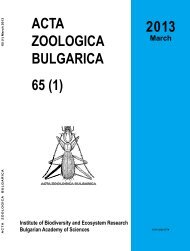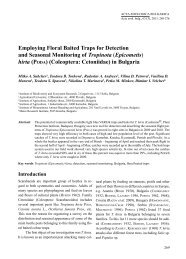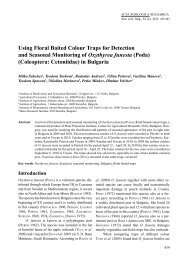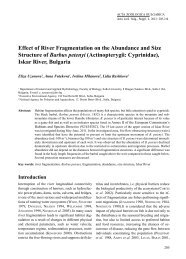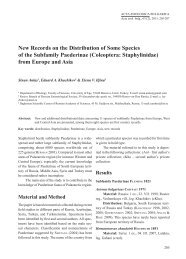from Vitosha Mountain: New Records for Bulgarian Fauna
from Vitosha Mountain: New Records for Bulgarian Fauna
from Vitosha Mountain: New Records for Bulgarian Fauna
Create successful ePaper yourself
Turn your PDF publications into a flip-book with our unique Google optimized e-Paper software.
ACTA ZOOLOGICA BULGARICA<br />
Acta zool. bulg., 65 (1), 2013: 125-129<br />
Pteromalidae (Hymenoptera: Chalcidoidea) <strong>from</strong> <strong>Vitosha</strong><br />
<strong>Mountain</strong>: <strong>New</strong> <strong>Records</strong> <strong>for</strong> <strong>Bulgarian</strong> <strong>Fauna</strong><br />
Ivaylo Todorov<br />
Institute of Biodiversity and Ecosystems Research, 1 Tsar Osvoboditel Blvd., 1000 Sofia, Bulgaria;<br />
E-mail: i.toddorov@abv.bg<br />
Abstract: This study presents in<strong>for</strong>mation about twenty pteromalid species distributed in mountain habitats. Nineteen<br />
of them are new to <strong>Vitosha</strong> <strong>Mountain</strong>. Sixteen species are new <strong>for</strong> <strong>Bulgarian</strong> fauna and eight are<br />
new <strong>for</strong> Balkan Peninsula. A new host <strong>for</strong> Mesopolobus sericeus (For s t e r, 1770) was established -<br />
Andricus mitratus (Cynipidae). One species – Coelopisthia caledonica Ask e w, 1980 was recorded <strong>for</strong><br />
first time <strong>from</strong> South-Eastern Europe and together with Pteromalus temporalis (GrA h A m, 1969) and<br />
Semiotellus fumipennis tho m s o n, 1876 are discussed as probable boreo-montane species. Four plant<br />
associations are also presented.<br />
Key words: Pteromalidae, <strong>Vitosha</strong> <strong>Mountain</strong>, new records, distribution, Bulgaria, Europe<br />
Introduction<br />
<strong>Vitosha</strong> <strong>Mountain</strong> is situated in Western Bulgaria. It<br />
is one of the highest mountain in the Balkans with<br />
maximum elevation of 2290 m a. s. l. Furthermore,<br />
<strong>Vitosha</strong> covers only 278 sq. km and these results in<br />
very high average altitude, which reaches to 1500 m.<br />
Almost the whole area of the mountain is included<br />
in <strong>Vitosha</strong> Natural Park and the most habitats are just<br />
partly affected by human activities.<br />
The pteromalid fauna of the mountain is<br />
poorly known. Twenty-one species were recorded<br />
at all – nine of them by thu r ò c z y (1990),<br />
one by Geo r G i e v & tA k o v (2005), three by<br />
Geo r G i e v & st o j A n o vA (2006) and eight species<br />
by tod o r o v (2011). The last author briefly<br />
discusses the previous studies on Pteromalidae<br />
<strong>for</strong> Bulgaria.<br />
Materials and methods<br />
Almost all specimens were catched by sweeping<br />
and Malaise traps by the author in the years 2010<br />
and 2011. Mesopolobus sericeus (For s t e r, 1770)<br />
was reared <strong>from</strong> a single host gall by Dr. Lilyana<br />
Vasileva-Samnalieva during her work on Cynipidae<br />
in the early 1980s. Collected material was dried<br />
following her At y & hA w k s (1998) and mounted<br />
according to some classic techniques (no y e s<br />
1982). Identification of the species was done using<br />
works of Ask e w (1980), Bou ć e k & Ra s p l u s<br />
(1991), dzh A n o k m e n (1996), GrA h A m (1969),<br />
GrA h A m (1992), hey d o n (1995), mitroiu<br />
(2010) and riz z o & mitroiu (2010). The examined<br />
material is deposited in the entomological<br />
collection of the Institute of Biodiversity and<br />
Ecosystem Research, <strong>Bulgarian</strong> Academy of<br />
Sciences.<br />
The species considered as new <strong>for</strong><br />
Balkan Peninsula are marked with one asterisk.<br />
Previously recorded <strong>from</strong> Bulgaria are<br />
Chlorocytus spicatus, Mesopolobus morys,<br />
Pteromalus elevatus and Pteromalus vibulenus<br />
(thu r ò c z y, 1990). Among the presented 20<br />
species, C. spicatus is the only one, recorded<br />
<strong>from</strong> <strong>Vitosha</strong> <strong>Mountain</strong> since this publication.<br />
125
Todorov I.<br />
Distributional data <strong>for</strong> each species follows<br />
mostly noy e s (2011).<br />
Results<br />
Miscogasterinae<br />
*Rhicnocoelia constans (Wa l k e R, 1836)<br />
Material examined: Shupni kamak area<br />
(42°30’19”N/23°15’27”E), 1446 m, 19. IX. 2010,<br />
1♂; Smilyo area (42°29’46”N/23°14’48”E), 1335<br />
m, 19. IX. 2010, 2♀, 2♂; Leva reka riverside<br />
(42°32’46”N/23°21’00”E), 1183 m, 23. IX. 2010,<br />
1♀; All specimens were collected by sweeping in<br />
meadows.<br />
Distribution: Holarctic.<br />
Seladerma geniculatum (Ze t t e R s t e d t, 1838)<br />
Material examined: Mecha cheshma<br />
spring (42°32’06”N/23°14’04”E), 1507 m, 18.<br />
VII. 2011, 1♀, coll. by sweeping in meadow.<br />
Distribution: Probably Holarctic, <strong>from</strong><br />
Europe to China, but also recorded <strong>from</strong><br />
Greenland (BAu r 2005).<br />
Ormocerinae<br />
*Semiotellus fumipennis tho m s o n, 1876<br />
Material examined: Gurgulitsa riverside<br />
(42°31’16”N/23°20’25”E), 1330 m, 25. V.-03.<br />
VI. 2010, 2♀; 03-12. VI. 2010, 1♀, 1♂; Coll. by<br />
Malaise trap.<br />
Distribution: United Kingdom, Netherlands,<br />
Sweden and Romania.<br />
Systasis encyrtoides Wal k e R, 1834<br />
Material examined: Kazana area<br />
(42°32’13”N/23°18’36”E), 1810 m, 17. VII. 2010,<br />
1♀; Barite area (42°31’27”N/23°20’21”E), 1397<br />
m, 14. VI. 2011, 1♂; 1418 m, 05. VII. 2011, 1♀,<br />
swept <strong>from</strong> Geranium sanguineum L.; Belite<br />
Brezi hut area (42°37’17”N/23°13’41”E), 1280<br />
m, 07. VII. 2011, 1♀; Mecha chesma spring<br />
(42°32’10”N/23°14’23”E), 1493 m, 08. VIII. 2011,<br />
1♀; Ostritsa hut area (42°35’14”N/23°12’24”E),<br />
1556 m, 31. V. 2011, 1♂; 07. VI. 2011, 1♀; 22. VI.<br />
2011, 1♀; The specimens were collected by sweeping<br />
in meadows.<br />
Distribution: Holarctic.<br />
*Systasis parvula tho m s o n, 1876<br />
Material examined: near Aslanov rid peak<br />
(42°30’34”N/23°13’29”E), 1358 m, 18. VII. 2011,<br />
126<br />
1♂; near Bukata area (42°32’04”N/23°11’48”E),<br />
1090 m, 16. VIII. 2011, 3♀; Selimitsa hut area<br />
(42°34’30”N/23°12’07”E), 1325 m, 20. VII. 2011, 1♂;<br />
Distribution: The species has been recorded<br />
<strong>from</strong> Nearctic, Oriental and Palearctic regions.<br />
Pireninae<br />
Macroglenes chalybeus (Ha l i d ay, 1833)<br />
Material examined: Marochki koshari area<br />
(42°30’50”N/23°15’32”E), 1468 m, 10. VII. 2011,<br />
2♂, coll. by sweeping in meadow.<br />
Distribution: Probably West Palearctic, recorded<br />
<strong>from</strong> Erope, Marocco and Central Kazakhstan.<br />
Macroglenes gramineus (Ha l i d ay, 1833)<br />
Material examined: Matnitsa riverside<br />
(42°32’49”N/23°13’07”E), 1262 m, 18. IX. 2011,<br />
1♀, coll. by sweeping in meadow.<br />
Distribution: Europe.<br />
Pteromalinae<br />
Chlorocytus spicatus (Wa l k e R, 1835)<br />
Material examined: Zlatni Mostove area<br />
(42°36’56”N/23°14’13”E), 1429 m, 07. VII.<br />
2010, 1♀, 1♂, swept <strong>from</strong> Chaerophyllum<br />
aureum L. Recorded <strong>from</strong> <strong>Vitosha</strong> Mts. by<br />
tHu R ό c Z y (1990).<br />
Distribution: Palearctic.<br />
*Coelopisthia caledonica Ask e w, 1980<br />
Material examined: Marochki koshari area<br />
(42°30’50”N/23°15’32”E), 1468 m, 27. VIII. 2011,<br />
4♀, 1♂, coll. by sweeping in meadow.<br />
Distribution: United Kingdom, Finland,<br />
Sweden, Switzerland and Eastern Turkey.<br />
Euneura sopolis (Wa l k e R, 1844)<br />
Material examined: Malinka hut area<br />
(42°36’02”N/23°13’45”E), 1532 m, 07. VII. 2010,<br />
1♀, coll. by sweeping in meadow.<br />
Distribution: Palearctic.<br />
Mesopolobus morys (Wa l k e R, 1848)<br />
Material examined: Kazana area<br />
(42°32’13”N/23°18’36”E), 1810 m, 17. VII. 2010,<br />
1♀, coll. by sweeping in high mountain grass associations;<br />
Malinka hut area (42°36’02”N/23°13’45”E),<br />
1532 m, 07. VII. 2010, 3♀, 2♂, coll. by<br />
sweeping in meadow; Trendafila hotel area<br />
(42°35’36”N/23°13’18”E), 1634 m, 29. VII. 2010,<br />
1♀, swept <strong>from</strong> Filipendula ulmaria L.; Zlatni mostove<br />
area (42°36’56”N/23°14’13”E), 1429 m, 07.
Pteromalidae (Hymenoptera: Chalcidoidea) <strong>from</strong> <strong>Vitosha</strong> <strong>Mountain</strong>: <strong>New</strong> <strong>Records</strong>...<br />
VII. 2010, 2♂, coll. by sweeping in meadow.<br />
Distribution: Holarctic.<br />
Mesopolobus sericeus (Fö r s t e r, 1770)<br />
Material examined: near Byalata voda area,<br />
17.X.1981, 4♀, 11♂ (L. Vasileva-Samnalieva),<br />
em. XII.1981 <strong>from</strong> gall of Andricus mitratus<br />
(mAy r 1870).<br />
Distribution: Europe, Turkey, Israel,<br />
Central Kazakhstan.<br />
Norbanus obscurus (mA s i, 1922)<br />
Material examined: near Bukata area<br />
(42°32’04”N/23°10’58”E), 1090 m, 16. VIII. 2011,<br />
1♂; Bukata area (42°31’51”N/23°11’43”E), 1108<br />
m, 30. VIII. 011, 1♂; specimens were collected by<br />
sweeping in grasslands.<br />
Distribution: Europe, Azerbaijan, Kazakhstan<br />
and Turkey.<br />
*Psilocera concolor (th o m s o n, 1878)<br />
Material examined: near Bosnek vill.<br />
(42°31’23”N/23°11’08”E), 1176 m, 30. VIII.<br />
2011, 1♀, swept <strong>from</strong> grasses in karst region.<br />
Distribution: Netherlands, Sweden, Italy,<br />
Czechoslovakia (GrA h A m, 1992) and Hungary.<br />
Psilocera crassispina (th o m s o n, 1878)<br />
Material examined: near Bosnek vill.<br />
(42°31’23”N/23°11’08”E), 1176 m, 16. VIII. 2011,<br />
1♀, 1♂, swept <strong>from</strong> grasses in karst region; near<br />
Bukata area (42°32’04”N/23°10’58”E), 1090 m, 16.<br />
VIII. 2011, 1♂, coll. by sweeping in grassland.<br />
Distribution: Europe and Central Kazakhstan.<br />
Pteromalus elevatus (Wa l k e R, 1834)<br />
Material examined: Barite area<br />
(42°31’27”N/23°20’21”E), 1397 m, 27. IX.<br />
2011, 3♀, 1♂; 29. IX. 2011, 5♀, 2♂, swept <strong>from</strong><br />
Centaurea phrygia L.; 2♀, 3♂, reared on 18, 22<br />
and 30. IX. 2011 <strong>from</strong> flower heads of C. phrygia<br />
L. Recorded <strong>from</strong> Bulgaria by tHu R ό c Z y<br />
(1990).<br />
Distribution: Holarctic region and<br />
Hawaii.<br />
*Pteromalus temporalis (Gr A h A m, 1969)<br />
Material examined: Kazana area<br />
(42°32’13”N/23°18’36”E), 1810 m, 17. VII. 2010,<br />
2♀, coll. by sweeping in high mountain grass associations;<br />
Mechkata area (42°38’16”N/23°13’24”E),<br />
1100 m, 20. VIII. 2010, 2♀, coll. by sweeping in<br />
meadow; 04.VIII.2011, 2♀, at the same habitat;<br />
Distribution: Netherlands, Spain, Sweden.<br />
Pteromalus vibulenus (Wa l k e R, 1839)<br />
Material examined: Barite area<br />
(42°31’27”N/23°20’21”E), 1397 m, 29. IX. 2011,<br />
2♀, coll. by sweeping; 4♀, reared on 25. IX. and<br />
03. X. 2011 <strong>from</strong> flower heads of C. phrygia l.;<br />
Shupni kamak area (42°30’08”N/23°15’27”E),<br />
1416 m, 27.VIII.2011, 3♀, reared on 21. IX.<br />
2011 <strong>from</strong> flower heads of C. rhenana Bor e A u.<br />
Recorded <strong>for</strong> Bulgaria by tHu R ό c Z y (1990).<br />
Distribution: Europe.<br />
*Stenomalina dives (Wa l k e R, 1835)<br />
Material examined: Marochki koshari area<br />
(42°30’59”N/23°15’35”E), 1492, 15. VIII. 2010,<br />
1♀; Shevovitsa area (42°32’25”N/23°20’54”E),<br />
1244 m, 03. VIII. 2011, 1♀; near Zheleznitsa vill.<br />
(42°32’18”N/23°20’58”E), 1207 m, 01. VII. 2010,<br />
1♀; coll. by sweeping.<br />
Distribution: Europe.<br />
*Stenomalina liparae (Gi R a u d, 1863)<br />
Material examined: Matnitsa riverside<br />
(42°32’52”N/23°13’42”E), 1338 m, 27.V.2011, 2♂,<br />
coll. by sweeping.<br />
Distribution: Europe, China.<br />
Discussion<br />
Among the listed pteromalids above, more detailed<br />
distributional analysis is needed <strong>for</strong> Coelopisthia<br />
caledonica, Pteromalus temporalis and Semiotellus<br />
fumipennis. These species have populations with<br />
clearly North European range of distribution but<br />
some others obviously exist in the mountains of<br />
South Europe or even Turkey (Fig. 1). For example,<br />
C. caledonica was recorded <strong>from</strong> Finland (lei et<br />
al. 1997), Northern England (key 1987), Sweden<br />
(Hed q v i s t 2003), Switzerland (BAu r 2000) and<br />
Erzurum province in Eastern Turkey (doG a n l a R<br />
1985). Ask e w (1980) has described this species using<br />
material <strong>from</strong> the highlands and western islands<br />
of Scotland and he supposes that C. caledonica may<br />
replace C. extenta in these areas. The second species,<br />
P. temporalis, was recorded only <strong>from</strong> three<br />
European countries – the Netherlands, Sweden<br />
(GrA h A m 1969) and <strong>from</strong> Guadarrama <strong>Mountain</strong>s<br />
in Spain (GaR R i d o & ni e v e s al d R e y 1992). The<br />
ormocerine S. fumipennis has a similar distribution<br />
– Netherlands (GijsWijt 2003), Carpathians in<br />
127
Todorov I.<br />
Fig. 1. Known localities of C. caledonica (■), P. temporalis (●) and S. fumipennis (▲).<br />
Romania (lás Z l ó 2007), Sweden (GrA h A m 1969)<br />
and England (Ask e w & ke n n A u G h 1992). Presence<br />
of these pteromalids in <strong>Vitosha</strong> <strong>Mountain</strong> supports<br />
an assumption that their ranges might be boreo-montane.<br />
Moreover, the females of S. fumipennis <strong>from</strong><br />
<strong>Vitosha</strong> are not clearly conspecific with the specimens<br />
described by Graham and Askew (GrA h A m<br />
1969; As k e w & ke n n A u G h 1992). Females <strong>from</strong><br />
Gurgulitsa riverside have relatively shorter marginal<br />
veins, being 2.31, 2.5 and 2.83 times as long as the<br />
stigmal vein in the three specimens respectively,<br />
not ‘just more than three times’ like these collected<br />
<strong>from</strong> Fletcher Moss Gardens by Askew or ‘about<br />
3.5 times’ as mentioned in Graham’s key. Additional<br />
morphometric measurements of the females shows<br />
also relatively shorter gaster - 0.93, 1.39 and 1.10<br />
times as long as head plus thorax, not ‘hardly 1.5<br />
times’ as indicated <strong>for</strong> the single female, collected<br />
by Graham at Wytham Wood, Berkshire, England.<br />
The differences above may be considered as a result<br />
of geographic isolation, but more material should be<br />
examined <strong>for</strong> assessment of their taxonomic importance.<br />
The male specimen <strong>from</strong> <strong>Vitosha</strong> <strong>Mountain</strong><br />
is conspecific with the description of the lectotype,<br />
noted by Graham.<br />
128<br />
Biological data presented in this work reveals<br />
one new host and six plant associations. The establishing<br />
of Andricus mitratus (Cynipidae) as a host of<br />
Mesopolobus sericeus is not surprising because this<br />
pteromalid attacks mainly cynipids of Andricus sp.,<br />
Cinips sp. and Synergus sp. (no y e s, 2011). The most<br />
plant associations were found by sweeping. Catching<br />
of Systasis encyrtoides on Geranium sanguineum,<br />
Chlorocytus spicatus on Chaerophyllum aureum and<br />
Mesopolobus morys on Filipendula ulmaria could be<br />
either accidental or related to some host-parasitoid<br />
relationships with phytophagous insects, living into<br />
the plant tissues. The emergence of Pteromalus elevatus<br />
and P. vibulenus <strong>from</strong> Centaurea phrygia and C.<br />
rhenana respectively clearly corresponds to the well<br />
known associations of these pteromalins with flower<br />
heads of many Centaurea species (no y e s 2011).<br />
Acknowledgments: This research was made by the support<br />
of two projects – CEBDER (financed by the National Science<br />
Fund at the Ministry of Education, Youth and Science of the<br />
Republic of Bulgaria) and ‘Development of scientific potential<br />
in the field of faunistic diversity and the protection of environment’<br />
(Funded by Ministry of Education, Youth and Science and<br />
the European Social Fund, Operative Programme ‘Human Resources<br />
Development’). The author is thankful to Dr. Dimitar<br />
Dimitrov (National Museum of Natural History, Sofia) <strong>for</strong> the<br />
identification of some plant species.
References<br />
Pteromalidae (Hymenoptera: Chalcidoidea) <strong>from</strong> <strong>Vitosha</strong> <strong>Mountain</strong>: <strong>New</strong> <strong>Records</strong>...<br />
Ask e w r. 1980. The European species of Coelopisthia (Hymenoptera:<br />
Pteromalidae). – Systematic Entomology, 5:<br />
1-6.<br />
Ask e w r. r., j. h. ke n n A u G h 1992. A review of the British<br />
species of Semiotellus Westwood (Hym., Pteromalidae). –<br />
Entomologist’s Monthly Magazine, 128: 216.<br />
BAu r h. 2000. Monophyly and relationship of the genus<br />
Coelopisthia Foerster (Chalcidoidea: Pteromalidae).<br />
– Hymenoptera evolution, biodiversity and biological<br />
control, 172.<br />
BAu r h. 2005. A review of the Eulophidae and Pteromalidae (Hymenoptera:<br />
Chalcidoidea) of Greenland. – Acta Societatis<br />
Zoologicae Bohemoslovenicae, 69 (1-2): 31.<br />
Bou ć e k Z., j.-y. Ra s p l u s 1991. Illustrated key to West-Palaearctic<br />
genera of Pteromalidae (Hymenoptera: Chalcidoidea),<br />
Institut National de la Recherche Agronomique, Paris,<br />
140 p.<br />
doG a n l a R M. 1985. Notes on Chalcidoidea of Turkey, II. Pteromalidae.<br />
– Türkiye Bitki Koruma Dergisi (Turkish Journal<br />
of Plant Protection), 9: 27-43.<br />
dzh A n o k m e n k. 1996. A review of pteromalids of the genus<br />
Systasis (Hymenoptera, Chalcidoidea, Pteromalidae) <strong>from</strong><br />
Kazakhstan. – Zoologicheskiy Zhurnal, 75 (12): 1788.<br />
GaR R i d o a. M., j. l. ni e v e s al d R e y 1992. Structure and dynamics<br />
of a taxocoenosis of Pteromalidae (Hym., Chalcidoidea)<br />
in the median sector of Sierra of Guadarrama. – Eos. Revista<br />
Española di Entomologia. Madrid., 68 (1): 29-49.<br />
Geo r G i e v G., d. tA k o v 2005. Impact of Tomicobia seitneri<br />
(ru s c h k A) (Hymenoptera: Pteromalidae) and Ropalophorus<br />
clavicornis (Wes M a e l) (Hymenoptera: Braconidae) on<br />
Ips typographus (lin n a e u s ) (Coleoptera: Scolytidae)<br />
populations in Bulgaria. – Forest Science, 40 (4): 61-67.<br />
Geo r G i e v G., A. st o j A n o vA 2006. <strong>New</strong> pteromalid parasitoids<br />
(Hymenoptera: Pteromalidae) of Ips typographus (L.)<br />
(Coleoptera: Scolytidae) in Bulgaria. – Silva Balcanica,<br />
7 (1): 89-93.<br />
GijsWijt M. j. 2003. Naamlijst van de Nederlandse bronswespen<br />
(Hymenoptera: Chalcidoidea). – Nederlandse Faunistische<br />
Mededelingen, 18: 54.<br />
GrA h A m m. w. r. d e v. 1969. The Pteromalidae of northwestern<br />
Europe (Hymenoptera: Chalcidoidea). – Bulletin<br />
of the British Museum (Natural History) (Entomology),<br />
Supplement 16: 908p.<br />
GrA h A m m. w. r. d e v. 1992. Second revision of western Eu-<br />
ropean Psilocera (Hym., Pteromalidae) with descriptions<br />
of three new species. – Entomologist’s Monthly Magazine,<br />
128: 15-21.<br />
Hed q v i s t k.-j. 2003. Katalog över svenska Chalcidoidea. – Entomologisk<br />
Tidskrift, 124 (1-2): 105.<br />
her At y j., d. hA w k s 1998. Hexamethyldisilazane: A chemical<br />
alternative <strong>for</strong> drying insects. – Entomological <strong>New</strong>s, 109:<br />
369-374.<br />
hey d o n s. 1995. The North American species of Systasis Walker<br />
(Hymenoptera: Pteromalidae). – Proceedings of the Entomological<br />
Society of Washington, 97 (3): 569-581.<br />
key r. s. 1987. Coelopisthia caledonica Askew and Pegopus inornatus<br />
Walker (Hymenoptera: Pteromalidae) at Highfields<br />
Enclosure, Malkam, Yorkshire. – Entomologist’s Monthly<br />
Magazine, 123 (1476-1479): 106.<br />
lás Z l ó Z. 2007. <strong>New</strong> records of Pteromalidae (Hymenoptera:<br />
Chalcidoidea) <strong>for</strong> the fauna of Romania and the Carpathian<br />
Basin. – Folia Entomologica Hungarica, 68: 176.<br />
lei G. c., v. vi k B e R G, M. ni e M i n e n, M. ku u s s a a R i 1997. The<br />
parasitoid complex attacking Finnish populations of the<br />
Glanville fritillary Melitaea cinxia (Lep: Nymphalidae),<br />
and endangered butterfly. – Journal of Natural History,<br />
31(4): 635-648.<br />
MitRoiu M.-d. 2010. Revision of the Palaearctic species of<br />
Macroglenes Westwood (Hymenoptera: Pteromalidae). –<br />
Zootaxa, 2563: 1-34.<br />
noy e s j. s. 1982. Collecting and preserving chalcid wasps (Hymenoptera:<br />
Chalcidoidea). – Journal of Natural History,<br />
16: 315-334.<br />
noy e s j.s. 2011. Universal Chalcidoidea Database. World<br />
Wide Web electronic publication. http://www.nhm.ac.uk/<br />
chalcidoids<br />
RiZ Z o M. c., M.-d MitRoiu. 2010. Revision of the European,<br />
North-African and Central Asian species of the genus<br />
Norbanus Walker 1843 (Hymenoptera: Pteromalidae). –<br />
Journal of Hymenoptera Research, 19 (2): 228-243.<br />
thu r ò c z y c. 1990. <strong>Bulgarian</strong> pteromalid fauna. I. Pteromalinae<br />
(Hymenoptera: Pteromalidae). – Acta Zoologica Bulgarica,<br />
58 (1): 61-66 (In <strong>Bulgarian</strong>, English summary).<br />
tod o r o v i. 2011. Contribution to the <strong>Bulgarian</strong> Pteromalid <strong>Fauna</strong><br />
(Chalcidoidea: Pteromalidae). – Acta Zoologica Bulgarica,<br />
62 (2): 151-156.<br />
Received: 26.04.2012<br />
Accepted: 12.06.2012<br />
129



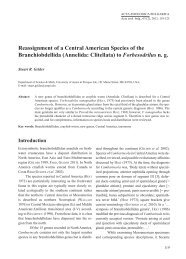
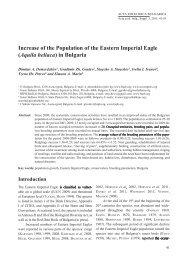
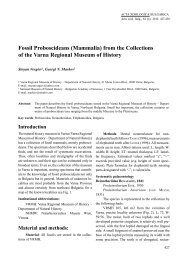
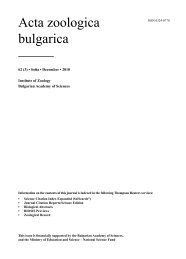
![table of contents [PDF] - Acta zoologica bulgarica](https://img.yumpu.com/52655254/1/186x260/table-of-contents-pdf-acta-zoologica-bulgarica.jpg?quality=85)
![table of contents [PDF] - Acta zoologica bulgarica](https://img.yumpu.com/52655255/1/186x260/table-of-contents-pdf-acta-zoologica-bulgarica.jpg?quality=85)
